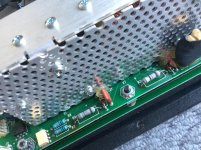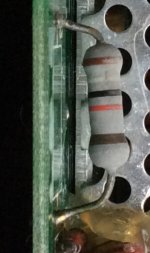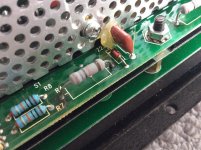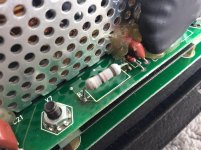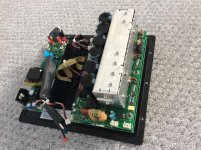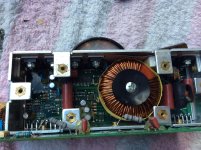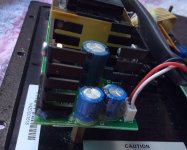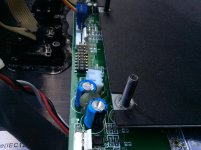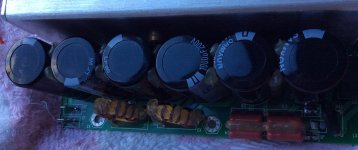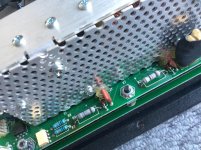Hi
Please help me to identify the value of the resistor,
It comes from my subwoofer amp. It seems to be 19k or 190k ohm.
It has ability to tolerate high temp. It is hot when touching.
Thanks
Please help me to identify the value of the resistor,
It comes from my subwoofer amp. It seems to be 19k or 190k ohm.
It has ability to tolerate high temp. It is hot when touching.
Thanks
Attachments
It seems to be 190 ohms, 2%, but the4 arrangement of the rings is a little ambiguous because the thick brown band seems odd or out of place to me.
Any chance you can try to identify the circuitry around it, what it's connected to and where?
Also, mentioning the brand and model of the amplifier might help, but that's not guaranteed.
Also, mentioning the brand and model of the amplifier might help, but that's not guaranteed.
Thank you very much for quick reply
It is Velodyne DD10. The circuit is power section. The resistor is R3 and R4 in the board. It is hot when running. That is why the colour is faded. Please look closely at the legs. The circuit board suffer heating with age. The colour turns into black
There is a hum and pop noise only when LFE detected. There is no noise , no hum when the sub is on
Someone have the same model with a good condition could tell
HI Pharos. The 4th band could be red or orange. I feel it is more red than orange. You mean 190ohm or 190 K ohm?
It is Velodyne DD10. The circuit is power section. The resistor is R3 and R4 in the board. It is hot when running. That is why the colour is faded. Please look closely at the legs. The circuit board suffer heating with age. The colour turns into black
There is a hum and pop noise only when LFE detected. There is no noise , no hum when the sub is on
Someone have the same model with a good condition could tell
HI Pharos. The 4th band could be red or orange. I feel it is more red than orange. You mean 190ohm or 190 K ohm?
Attachments
Why not just unsolder one end and measure it. You'll probably get a value that makes sense and you will say 'ah, so that's what the colours were' 🙂
If R3 and R4 are the same then you have two to work with.
They are 'Metal Oxide' types and ideally suited for high voltage high temperature applications. They rarely fail in my experience and were commonly used in TV's back in the day.
If R3 and R4 are the same then you have two to work with.
They are 'Metal Oxide' types and ideally suited for high voltage high temperature applications. They rarely fail in my experience and were commonly used in TV's back in the day.
I think it is a 190kilohm resistor if the fourth band is orange or it is 19kilohm if it is red.
The colour coding is 5 band: brown (1), white (9), black (0) = 190
If 4th band is red then multiply by 100, so have 19000 ohms
The fifth band is brown, 1% tolerance.
Regards,
Rick
The colour coding is 5 band: brown (1), white (9), black (0) = 190
If 4th band is red then multiply by 100, so have 19000 ohms
The fifth band is brown, 1% tolerance.
Regards,
Rick
They look to be the series dropper resistors for those two Zener diodes. It might help to know the rough voltages that each end is (supposed to be) at.
Zener diode - Wikipedia
Zener diode - Wikipedia
I did wonder if what looks white could in fact have been grey and lightened with the heat. 19 anything is just a bit of an unlikely value for common usage.
Having just measured the twos, one 18.2k , the other is 16.3k ohm. They seem to have the same colour code. But, the result are different. I think they are 19000 ohm resistor.
Brown, White, Black and Red
Brown, White, Black and Red
That's a curious result but interesting. I'd bet 18k is the original value. Recheck the one that is low and make sure you are not contributing to the total by gripping the leads with fingers 😉
If it is genuinely low in value then I'd replace both with new 18k's. The Metal Oxide types have a very high operational maximum temperature of over 400C.
If it is genuinely low in value then I'd replace both with new 18k's. The Metal Oxide types have a very high operational maximum temperature of over 400C.
Visionally check all the capacitors, they are all fine. ( I may be wrong)
Attachments
I'm going to muddy the waters again...
Is the one that measures 16k the one at the left in that last image?
The colour code on that one looks very different to the other... could that second band be blue?
Is the one that measures 16k the one at the left in that last image?
The colour code on that one looks very different to the other... could that second band be blue?
Hi Mooly
Thanks for your questions
As you see in the photos, all Resistors were disconnected from the board before testing.
The left one :18,2 K ( it looks older than the right )
The right : 16,3k ( the one near the transformer)
Please look at the photo below . The photo was taken BEFORE I clean them by alcohol. The right resistor looks cleaner. My mistake. It made the colour code fader than it is.
Thanks for your questions
As you see in the photos, all Resistors were disconnected from the board before testing.
The left one :18,2 K ( it looks older than the right )
The right : 16,3k ( the one near the transformer)
Please look at the photo below . The photo was taken BEFORE I clean them by alcohol. The right resistor looks cleaner. My mistake. It made the colour code fader than it is.
Attachments
OK 🙂 So doubt and confusion reign over what they might be.
Khron mentioned the diodes next to these resistors look like they might be Zeners. I agree, its a classic configuration. If so then you probably have a lot of leeway on what would actually work.
If it really did originally look like the other resistor then is it an 18k that has gone low?
As there is doubt I think all you can do is go off what you believe to be correct, that both were the same visually and assume it has gone low in value (rare situation but not unknown) and replace both with new 18k metal oxides.
Khron mentioned the diodes next to these resistors look like they might be Zeners. I agree, its a classic configuration. If so then you probably have a lot of leeway on what would actually work.
If it really did originally look like the other resistor then is it an 18k that has gone low?
As there is doubt I think all you can do is go off what you believe to be correct, that both were the same visually and assume it has gone low in value (rare situation but not unknown) and replace both with new 18k metal oxides.
- Home
- Amplifiers
- Class D
- Please help to identify that resistor
